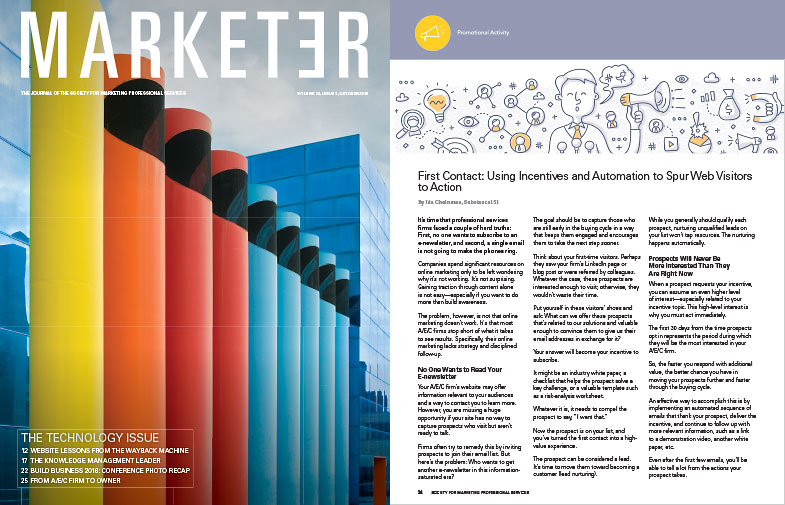This article was first published in the SMPS Marketer – bimonthly journal by the Society for Marketing Professional Services (SMPS).

Companies spend significant resources on online marketing only to be left wondering why it’s “not working.” It’s not surprising. Gaining traction through content alone is not easy – especially if you want to do more than “build awareness.”
The problem, however, is not that online marketing doesn’t work, but that most firms stop short of what it takes to see results. Specifically, their online marketing lacks strategy and disciplined follow-up.
Your firm’s website may offer information relevant to your audiences and a way to contact you to learn more – however, you are missing a huge opportunity if your site has no way to capture prospects who visit but aren’t ready to talk.
Firms often try to remedy this by inviting prospects to join their email list. But here’s the problem: Who wants to get another e-newsletter in this information-saturated era?
The goal should be to capture those who are still early in the buying cycle in a way that keeps them engaged and encourages them to take the next step sooner.
Think about your first-time visitors. Perhaps they saw your firm’s LinkedIn page or blog post or were referred by colleagues. In any case, these prospects are interested enough to visit; otherwise, they wouldn’t waste their time.
Put yourself in these visitors’ shoes and ask: What can we offer these prospects that’s related to our solutions and valuable enough to convince them to give us their email addresses in exchange for it?
Your answer will become your subscribe incentive.
It might be an industry white paper, a checklist that helps the prospect solve a key challenge, or a valuable template such as a risk analysis worksheet.
Whatever it is, it needs to compel the prospect to say, “I want that.”
Now the prospect is on your list, and you’ve turned the first contact into a high-value experience.
The prospect can be considered a lead. It’s time to move the prospect toward becoming a customer (lead nurturing).
While you generally should qualify each prospect, nurturing unqualified leads on your list won’t tap resources. The nurturing happens automatically.
When a prospect requests your incentive, you can assume an even higher level of interest – especially related to your incentive topic. This high-level interest is why you must act immediately.
The first 30 days from the time prospects opt in represents the period during which they will be the most interested in your firm.
So, the faster you respond with additional value, the better chance you have in moving your prospects further and faster through the buying cycle.
The only effective way to accomplish this is by implementing an automated sequence of emails that thank your prospect, deliver the incentive, and continue to follow up with more relevant information, such as a link to a demonstration video, another white paper, etc.
Even after the first few emails, you’ll be able to tell a lot from the actions your prospect takes.
For example, clicking through to access a second piece of related content might be enough for your marketing department to deem that prospect ready for a call or email from your sales team.
Most likely, though, you’ll want to send multiple messages within those first 30 days.
There are endless options for what a firm can do within its automated lead nurturing sequence. The goal is to create something that’s strategic, relevant, compelling, and designed to get prospects talking with your sales team by the time the sequence ends.
Once the automated email sequence is over, less qualified or not ready prospects can be put on your general email list – with your marketing department continuing to monitor and analyze their readiness.
It’s possible that your prospect will pick up the phone within the first 30 days. But you can’t expect that to happen.
Marketing’s job is to generate and nurture leads until they’re ready to be handed to the sales team. One of the biggest misconceptions is that if you keep writing articles and posting on social media, prospects will call.
What firms need to realize is that online marketing is designed to start the process, not to finish it.
If you make your first contact strategically and employ disciplined follow-up, you may be the only firm in your competitive set getting real ROI from its online communications.